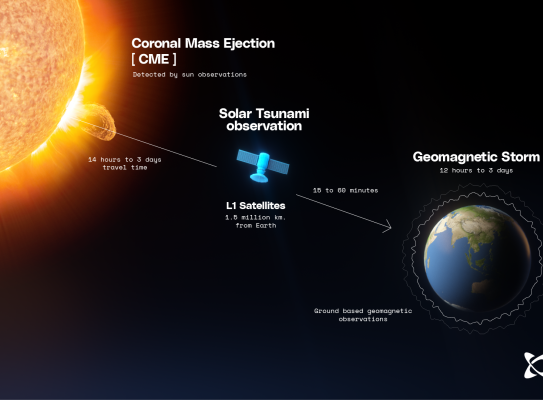Space Weather

Activity on the Sun’s surface creates what we call space weather, which can impact our national infrastructure, technology, and communications systems.
GNS Science is one of many geomagnetic teams across the globe that measure and monitor the Earth's magnetic field and how it is being impacted by space weather events.
We continuously record changes in the Earth’s magnetic field at these geomagnetic observatories using instruments that we call magnetometers. These magnetometers can record the rapid changes of the Earth’s magnetic field (also known as geomagnetic field changes) associated with solar storms, as well as other geologic processes.
This geomagnetic data is available close to real-time on the GeoNet website.
How do we know a geomagnetic storm is coming?
Space weather prediction centres around the globe watch the Sun’s activity closely and provide a warning that a geomagnetic storm is coming.
An extreme solar event like a coronal mass ejection (CMEs), which are explosions of plasma and magnetic fields from the sun that are ejected out into space, can be detected when they occur and if they are directed near or toward Earth.
Although uncommon, large space weather events have occurred globally and in New Zealand in the past, causing electricity blackouts and damage to infrastructure. Solar storms send electric currents into the ground, that can, when large enough, potentially be very harmful to New Zealand’s power transmission system
The travel time for this solar activity from the Sun to our next point of contact, L1 satellites, is between 12 hours and three days. It then takes 15 minutes to an hour, before it will reach Earth and be picked up by our magnetometers. We then continue to record solar activity for hours and sometimes days from their first arrival.
This warning allows organisations like Transpower to engage their contingency plans for geomagnetic storms, and do their best to reduce damage, while continuing to supply the nation with electricity.
Does this mean we will see an aurora?
When solar particles from CMEs penetrate the Earth's magnetic field they interact with gases around the earths magnetic poles - causing aurora.
Aurora are natural light displays that shimmer in the sky, they are visible at night, and usually only appear in lower polar regions.
If there is a large CME there is a chance to see aurora in more places in New Zealand and around the globe.
The future of space weather
The Solar Tsunami Endeavour Programme (external link) is an international collaboration led by the University of Otago, including experts from GNS, to understand how New Zealand’s energy infrastructure will be impacted by an extreme space weather event.
The research from this programme aims to find out how likely and big future storms could be, if they can be forecast and what impact they would have on our critical energy supply networks.